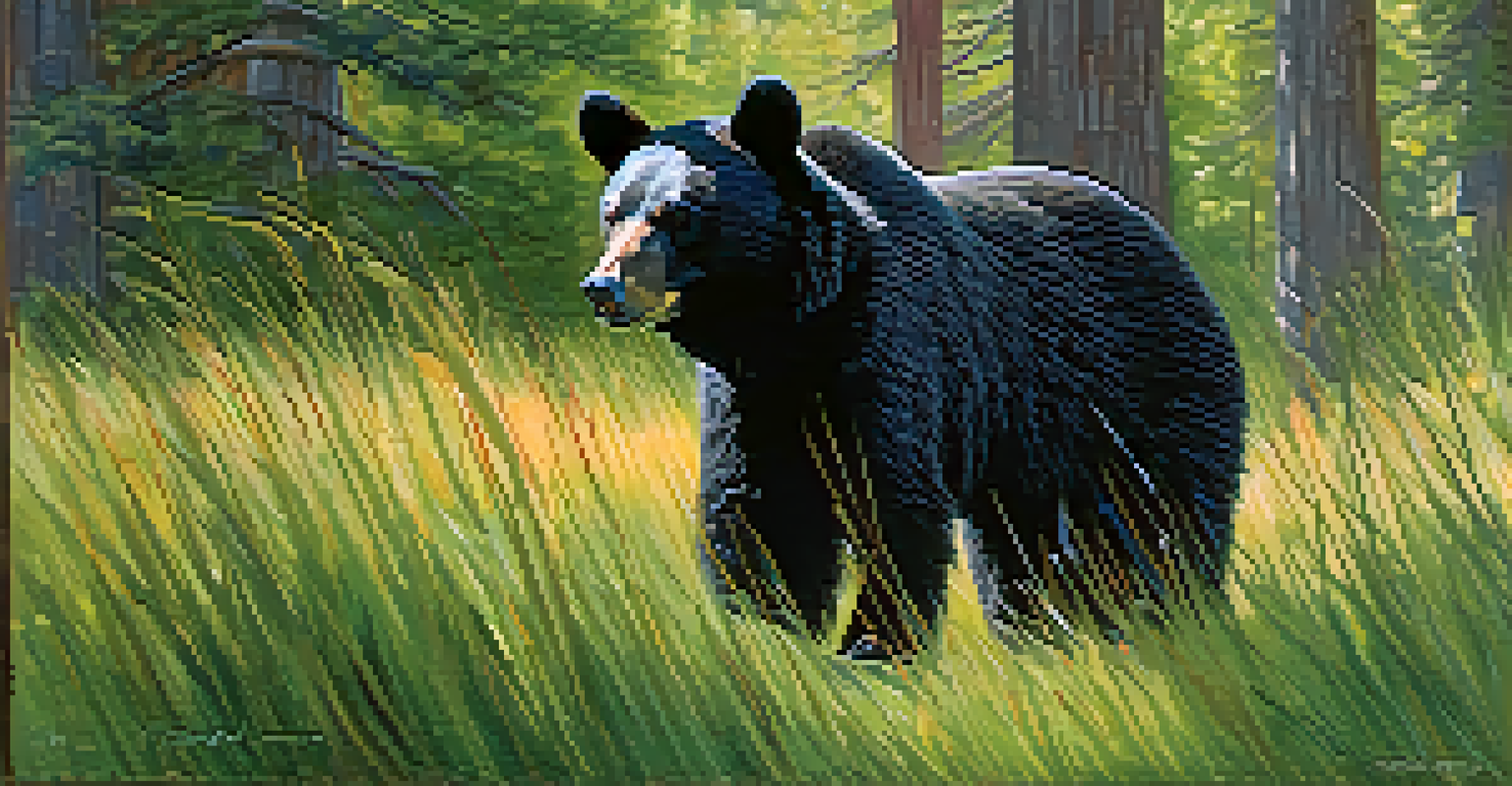Understanding Big Bear's Ecosystem: A Wildlife Overview

Introduction to Big Bear's Diverse Ecosystem
Big Bear Lake, nestled in the San Bernardino Mountains, boasts a rich and diverse ecosystem. This area is home to various habitats including forests, meadows, and waterways, each supporting unique wildlife. Understanding this delicate balance is essential for conservation efforts and the enjoyment of visitors.
In every walk with nature one receives far more than he seeks.
The region's elevation and climate contribute to its diverse flora and fauna. You'll find everything from towering pines to vibrant wildflowers, which in turn support various animal species. This interconnectedness makes Big Bear an intriguing subject for nature enthusiasts and researchers alike.
Exploring Big Bear's ecosystem not only offers recreational opportunities but also deepens our appreciation for nature's complexity. As we delve into the wildlife that calls this area home, we'll uncover how each species plays a vital role in maintaining ecological balance.
Key Species: Mammals of Big Bear
Big Bear is home to a variety of mammals, including black bears, deer, and coyotes. The black bear, a symbol of the region, thrives in the forested areas, and spotting one can be a thrilling experience for hikers. These bears play a crucial role in the ecosystem by helping to disseminate seeds and maintain plant diversity.

Mule deer are another common sight, especially in the meadows and valleys. They contribute to the balance in the ecosystem by grazing on vegetation, which encourages new growth. Meanwhile, coyotes, often misunderstood, are vital for controlling rodent populations and maintaining a healthy food web.
Big Bear's Rich Ecosystem Diversity
Big Bear Lake features a unique blend of habitats that support a variety of wildlife, highlighting the importance of ecological balance.
These mammals not only enhance the biodiversity of Big Bear but also provide opportunities for wildlife observation and photography. Understanding their behaviors and roles helps us appreciate their place in this vibrant ecosystem.
Birdlife: A Feathered Community
Birdwatchers will find Big Bear a paradise, teeming with avian life. From majestic bald eagles soaring above the lake to colorful hummingbirds flitting between flowers, the variety is astounding. Each species contributes uniquely to the ecosystem, whether through pollination or pest control.
The future will be shaped by the decisions we make today.
Migratory birds also pass through Big Bear, adding to the area's dynamic wildlife. During certain seasons, you can witness flocks of ducks and geese taking a break at the lake, offering a spectacular sight for nature lovers. This migration pattern helps maintain genetic diversity among bird populations.
The presence of diverse bird species also indicates a healthy ecosystem, making them excellent indicators of environmental changes. Observing their behaviors and habitats can deepen our connection to nature and highlight the importance of conservation efforts.
Reptiles and Amphibians: The Quiet Residents
While they may not be as prominent as mammals or birds, reptiles and amphibians play essential roles in Big Bear's ecosystem. Species like the Western rattlesnake and various frogs contribute to the food chain, controlling insect populations and providing food for larger predators. Their presence can indicate the health of the environment.
These creatures thrive in the diverse habitats found around Big Bear, from rocky outcrops to the edges of wetlands. Observing them can sometimes require patience, as they often blend into their surroundings. However, their adaptations for survival are fascinating and worth the effort.
Essential Roles of Local Wildlife
Mammals, birds, reptiles, and amphibians in Big Bear play crucial roles in maintaining the ecosystem's health and biodiversity.
Understanding the roles of reptiles and amphibians helps us appreciate the complexity of the ecosystem. They remind us that every creature, no matter how small or seemingly insignificant, plays a part in the grand tapestry of life.
Flora: The Foundation of Big Bear's Ecosystem
The flora of Big Bear is as diverse as its fauna, ranging from towering conifers to wildflowers that bloom in the spring. These plants not only provide food and shelter for wildlife but also play a crucial role in the ecosystem's health. Trees like the Jeffrey pine and white fir are integral to the forest's structure and stability.
Wildflowers, such as lupines and monkey flowers, add color and vibrancy to the landscape. They attract pollinators like bees and butterflies, which are essential for plant reproduction. This relationship showcases the interconnectedness of life in Big Bear, where plants and animals support one another.
By exploring the rich plant life in Big Bear, we gain insights into how ecosystems function. It reminds us of the importance of preserving these habitats for future generations and the wildlife that depend on them.
Conservation Efforts in Big Bear
Conservation efforts in Big Bear are vital to protecting its unique ecosystem. Local organizations and government agencies work tirelessly to maintain habitats, monitor wildlife populations, and educate the public about responsible outdoor practices. These initiatives are crucial for ensuring the long-term health of the area.
Community involvement plays a significant role in these efforts. Residents and visitors alike are encouraged to participate in clean-up events, wildlife monitoring programs, and educational workshops. This collective action fosters a sense of stewardship and responsibility toward the environment.
Importance of Conservation Efforts
Local conservation initiatives are vital for protecting Big Bear's diverse ecosystems and engaging the community in responsible stewardship.
By supporting conservation efforts, we can help preserve Big Bear's rich biodiversity for future generations. Understanding the importance of these initiatives empowers us to make informed choices and advocate for the protection of this beautiful area.
Experiencing Big Bear's Wildlife: Best Practices
Experiencing Big Bear's wildlife is a rewarding adventure, but it comes with responsibilities. Adhering to best practices ensures both your safety and the well-being of the animals. This includes maintaining a respectful distance from wildlife and never feeding them, as human food can be harmful.
Engaging in eco-friendly activities like hiking, birdwatching, and photography allows you to appreciate nature without disrupting it. Utilizing marked trails and designated viewing areas helps protect sensitive habitats and keeps wildlife safe. Remember, being a responsible visitor contributes to the preservation of Big Bear's ecosystem.

Lastly, educating yourself about the local wildlife enriches your experience. Understanding the behaviors and roles of different species enhances your appreciation for the intricate web of life in Big Bear, making your visit all the more meaningful.